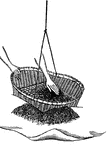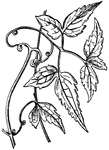
Leaves in Furnace
Five pounds of tea leaves are taken out of the steam bath and put in a stone furnace.

Gridiron support (Tea Making)
A wooden tray designed to encase a gridiron support, which in turn holds tea leaves heated in the furnace.

Sorting Leaves
The tea leaves are taken to long, low tables where the stems and uncurled leaves are separated and discarded.
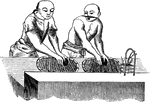
Tea Balls
The tea leaves are steamed until they reach a desirable fragrance. They are then rolled or kneaded by…
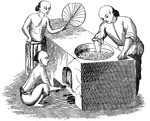
Tea Leaf Treatment
A kuo basket is placed above a furnace to be hand-stirred by a worker in order to regulate the leaf…
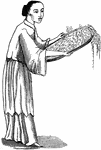
Winnowing Tea Leaves
Tea leaves are passed through sieves then winnowed via tossing on large bamboo trays.

Kuo in Stove
A kuo, used in making tea, is placed in a stove about nine inches below the stove's mouth.
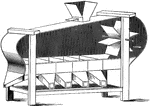
Winnowing Machine
A winnowing machine was traditionally used to separate yield from chaff. The pictured type of winnowing…

Geum Urbanum
Geum urbanum is a member of the genus Geum, a genus of hardy plants (Rosaceae). Not usually used decoratively,…

British Golden-rod
British Golden-rod is a member of the large composite genus Solidago, which is chiefly North American.…

Softening Process in the Manufacturing of Jute
In the manufacturing of jute, the jute fiber must first be softened. The softening machine consists…
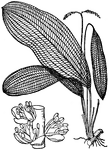
Lattice Leaf
Lattice Leaf is the popular name of a water plant, 'Aponogeton jenestralis', belonging to the order…

Types of Simple Leaves
This illustration shows 4 types of simple leaves: 1. Linear (an elongated version of the elliptical);…
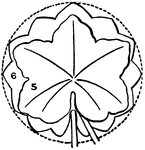
Types of Simple Leaves Derived from the Circular Type
This illustration shows two types of leaves derived from the circular type: 5. Palmately lobed; 6. Orbicular…
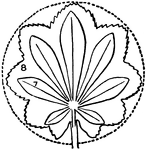
Compound Leaves Derived from the Circular Type
This illustration shows two types of compound leaves derived from the circular type: 7. palmately compound;…

Simple Leaves Derived from the Elliptical Type
This illustration shows two types of simple leaves derived from the elliptical type: 9. pinnately lobed;…

Compound Leaves Derived from the Elliptical Type
This illustration shows two compound leaves derived from the elliptical type: 11, 12. bipinnate.

Leaves Derived from the Oval Type
This illustration shows leaves derived from the oval type: 13. Ovate and Serrate; 14. Palmately three…

Colored Leaves of 'Cornus florida'
This illustration shows the colored leaves of 'Cornus florida', surrounding the small flowers and rendering…
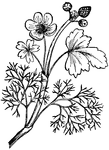
Water Crowfoot
This illustration shows a water crowfoot, with broad, floating leaves, and much-cut, submerged leaves.
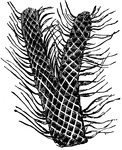
Portion of Lepidodendron
This illustration shows a portion of Lepidodendron. Lepidodendron is the generic name of a large and…

Hedge Garlic
Hedge Garlic (Sisymbrium Allaria). A, Inflorescence and Cauline Leaves. B, Radical Leaf and Root.
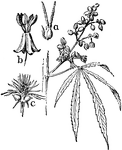
Hemp Leaf and Flowers
Leaf and flowers of the hemp plant (Cannabis sativa). A and c are female flowers, while b is a male…
Sweet Potato Plant
A branch of a vineless sweet potato plant, showing the crowded position of leaf stems.

Sweet Potato Leaves
Three shapes of sweet potato leaves. On left, cut-leaf type; in center, shouldered leaf; and on right,…

Tobacco Leaves
Broad and narrow tobacco leaves. The image is to show that bigger leaves can afford a larger number…

Apollo of the Belvedere - Front View of Statue
Illustration of the famous statue Apollo Belvedere. Created circa AD120-140, the statue depicts Apollo…

Pompeii Graffiti from the House of Dioscuri - Gladiator Holding Palm Leaf
A drawing of one section of the graffiti found on the house of Dioscuri in Pompeii. A gladiator descends…
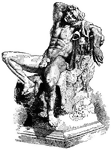
The Barberini Faun, or Drunken Satyr
Illustration of the life-size marble statue located in Munich, Germany. It was found in 1620 in a moat…
Ryegrass Leaf with Sheath
Lolium perenne. A sheath, in botany is "the part of an expanded organ that is rolled around a stem or…
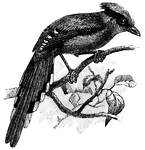
Sirgang
"The so-called green jackdaw of Asia, Cissa sinensis. The sirgang inhabits the southeastern Himalayan…
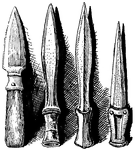
Skeans - Ancient Irish Daggers
"A dagger; specifically, an ancient form of dagger found Ireland, usually of bronze, double-edged, and…

Sow Thistle - Stem with Heads, Basal Leaves, Flower, Achene with Pappus
"A plant of the genus Sonchus, primarily S. oleraceus, a weed of waste places, probably native in Europe…

Hardhack Leaf
Spiraea tomentosa. Also called Steeplebush and Meadowsweet, this plant grows up to four feet high. This…
Divider with Leaves and Sun Rays
This divider has leaves and small round kernels featured in a design on the sides. The center area has…

